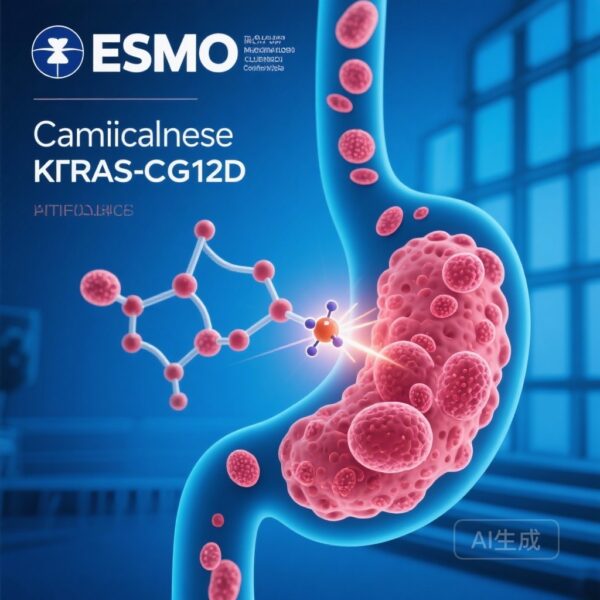Highlight
– The multicentre ENAVEN‑AML phase 1b/2 trial evaluated enasidenib (IDH2 inhibitor) plus venetoclax (BCL‑2 inhibitor) in 27 patients with relapsed or refractory IDH2‑mutant acute myeloid leukaemia (AML) or myelodysplastic syndrome (MDS).
– The combination produced an overall response rate (ORR) of 62% (16/26) in patients with AML, with 50% (13/26) achieving complete remission.
– Safety was notable for high rates of grade ≥3 febrile neutropenia and infections; no dose‑limiting toxicities or treatment‑related deaths were observed. Recommended phase 2 doses were venetoclax 400 mg daily and enasidenib 100 mg daily.
Background: clinical need and biological rationale
IDH2 mutations are recurrent in adult acute myeloid leukaemia (AML) and define a molecularly targetable subgroup. Mutant IDH2 produces the oncometabolite 2‑hydroxyglutarate, which impairs normal hematopoietic differentiation. Enasidenib, an oral selective IDH2 inhibitor, induces differentiation and has demonstrated single‑agent activity in relapsed/refractory IDH2‑mutant AML. Venetoclax, an oral BCL‑2 inhibitor, has shown synergy with hypomethylating agents and cytotoxic chemotherapy by promoting apoptosis of malignant myeloid cells. Preclinical models suggest that IDH‑mutant AML cells exhibit relative dependence on BCL‑2 and that combining IDH2 inhibition with venetoclax can produce additive or synergistic antileukaemic effects. However, clinical evaluation of this dual targeted strategy in the relapsed/refractory setting has been limited. The ENAVEN‑AML trial addresses this gap by testing the combination in patients with IDH2‑mutant disease who have failed at least one prior therapy.
Study design and methods
ENAVEN‑AML was a multicentre, single‑arm, phase 1b/2 trial conducted at two Canadian centres and registered as NCT04092179. Eligible adults (≥18 years) had performance status ECOG 0–2, a confirmed IDH2 mutation (Arg140 or Arg172), and relapsed or refractory AML or MDS after at least one prior line of therapy. Treatment consisted of oral venetoclax with a 3‑day ramp to 400 mg daily beginning cycle 1 day 1, and oral enasidenib 100 mg daily starting cycle 1 day 15. The phase 1b portion evaluated safety, dose‑limiting toxicity (DLT), and established a recommended phase 2 dose (RP2D). The phase 2 portion assessed preliminary antileukaemic activity with overall response rate (ORR) by intention‑to‑treat (ITT) as the primary endpoint. Safety and efficacy were analysed on pooled data from both parts of the study.
Key findings
Between Nov 12, 2020, and July 5, 2022, 27 patients were enrolled (13 phase 1b; 14 phase 2). Median follow‑up at the Sept 30, 2023 cutoff was 20.2 months (IQR 15.0–23.0). Baseline characteristics included a median age of 70 years (IQR 55–76); 26 patients had relapsed/refractory AML and one had relapsed MDS.
Efficacy
Among the 26 evaluable patients with AML, the ORR was 62% (95% CI 41–80; 16/26). Complete remissions (CR) were observed in 13/26 (50%). The single patient with relapsed MDS did not respond. These results indicate substantial activity of the two‑drug regimen in a heavily pretreated, molecularly selected population.
Safety
The primary safety signals were hematologic and infectious. The most common grade ≥3 treatment‑emergent adverse events (TEAEs) were febrile neutropenia (11/27, 41%), infections overall (8/27, 30%), thrombocytopenia (7/27, 26%), pneumonia (6/27, 22%), sepsis (5/27, 19%), and anaemia (5/27, 19%). One case of IDH inhibitor‑associated differentiation syndrome was reported. Serious adverse events (SAEs) occurred in 17/27 (62%), most commonly infections (11/27, 41%) and intracranial bleeding (5/27, 19%). No dose‑limiting toxicities or treatment‑related deaths occurred. Based on safety and tolerability, the RP2D was venetoclax 400 mg daily and enasidenib 100 mg daily.
Interpretation and clinical implications
ENAVEN‑AML demonstrates that combining enasidenib with venetoclax is feasible, tolerable at full single‑agent doses, and produces encouraging response rates in relapsed/refractory IDH2‑mutant AML. The observed ORR of 62% and CR rate of 50% in this small cohort are notable and support the biological rationale that dual inhibition of IDH2 and BCL‑2 can produce clinically meaningful antileukaemic activity.
However, the toxicity profile—particularly high rates of febrile neutropenia, serious infections, and intracranial bleeding events—warrants caution. Many patients with relapsed/refractory AML are already at high baseline risk for myelosuppression and infections; adding venetoclax (which produces profound early cytopenias in AML combinations) to enasidenib appears to increase infectious morbidity. The absence of treatment‑related deaths and lack of DLTs are reassuring, but close monitoring, infection prophylaxis, and strategies to mitigate cytopenias (dose interruptions, growth‑factor support) are likely to be important in clinical practice or future studies.
Because ENAVEN‑AML is a single‑arm study without a randomized comparator, efficacy should be interpreted against historical expectations cautiously. The study size is small and patient selection may influence outcomes; therefore, confirmatory randomized trials or larger prospective cohorts will be necessary to define the benefit of the combination versus available salvage options, venetoclax‑based regimens, or single‑agent enasidenib.
Strengths and limitations
Strengths of the study include molecular selection for IDH2 mutation, prospective assessment of safety and activity, and a mature follow‑up period. The trial provides a clear signal of activity that justifies further investigation.
Key limitations are the single‑arm design, small sample size (n=27), heterogeneous prior therapies and lines of treatment, and limited correlative molecular analyses reported in the primary summary. The relatively high rate of intracranial bleeding events is striking and requires careful adjudication and exploration of contributing factors (baseline coagulopathy, thrombocytopenia severity, concomitant medications). The single enrolled MDS patient precludes conclusions for that population.
Biological and translational considerations
The combination targets complementary vulnerabilities: enasidenib reduces 2‑HG levels and releases differentiation blocks, while venetoclax engages the intrinsic apoptosis pathway, which IDH‑mutant blasts may be particularly dependent upon. Correlative work examining 2‑HG suppression, changes in apoptotic priming, clonal dynamics, and influence of co‑mutations (e.g., NPM1, FLT3, TP53, ASXL1) will be crucial to identify which patients derive the greatest benefit and to design rational sequencing or triplet strategies.
Future directions
Important next steps include: (1) randomized trials comparing enasidenib plus venetoclax to standard salvage regimens or to enasidenib alone; (2) exploration of the combination earlier in the disease course (e.g., first relapse or frontline for patients unfit for intensive chemotherapy); (3) detailed correlative studies to define biomarkers of response and resistance; (4) optimization of supportive care algorithms to reduce infection risk and manage cytopenias; and (5) assessment of duration of response and overall survival in larger cohorts.
Practical takeaways for clinicians
– For patients with relapsed or refractory IDH2‑mutant AML, enasidenib plus venetoclax is a promising targeted option supported by phase 1b/2 data showing high CR and ORR rates.
– Treatment requires intensive monitoring for neutropenia and infectious complications; consider prophylactic measures, early growth‑factor support, and careful assessment of bleeding risk and platelet nadirs.
– The regimen should be considered investigational outside of trial settings until confirmatory data are available; referral to trials or centres conducting further research is encouraged.
Conclusion
The ENAVEN‑AML trial provides an important proof‑of‑concept that targeting both mutant IDH2 and BCL‑2 can yield substantial clinical responses in relapsed/refractory IDH2‑mutant AML. While efficacy signals are encouraging, infectious morbidity and serious bleeding events underscore the need for cautious application and further study in randomized and larger cohorts. Correlative science to refine patient selection and supportive care strategies to reduce toxicity will determine the ultimate role of this combination in clinical practice.
Funding and registration
Funding: AbbVie and Bristol Myers Squibb. ClinicalTrials.gov registration: NCT04092179.
Selected reference
Richard‑Carpentier G, Gupta G, Koraksic C, et al. Enasidenib plus venetoclax in patients with IDH2‑mutated relapsed or refractory acute myeloid leukaemia or myelodysplastic syndrome (ENAVEN‑AML): a multicentre, single‑arm, phase 1b/2 trial. Lancet Haematol. 2025 Nov;12(11):e887‑e897. doi: 10.1016/S2352‑3026(25)00254‑6. PMID: 41075807.



